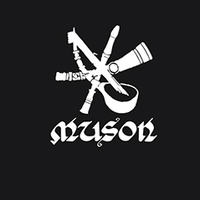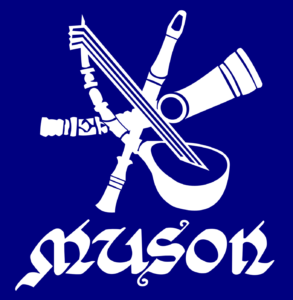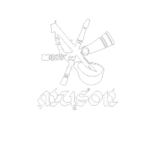- Latest news update
PLEASE CLICK ON ANY OF THE LINKS TO REGISTER FOR NOVEMBER 2024 MUSON GRADED EXAMINATION. IF YOU ARE REGISTERING FOR BOTH THEORY & PRACTICAL, KINDLY FILL ONE AFTER THE OTHER. PLEASE READ INSTRUCTIONS BEFORE FILLING THE FORM.

THEORY OF MUSIC SYLLABUS
- The staves, clefs and alphabetical names of lines and spaces
- Names and time values of notes and rests including dotted minim and dotted crotchet.
- The key signature and major scales up to one sharp and one flat
- Simple time signatures, grouping of quavers in simple time 2 3 4 4 4 4
- The sharp, flat and natural signs as accidentals
- Simple terms and signs relating to tone, pace, strength and expression.
More advanced questions on the requirements for the above grade with the addition of the following:
- Ledger lines not exceeding two above or two below the stave
- The major keys and scales of B flat and D; and the harmonic minors of A, E, D.
- The tonic triads of the above keys
- Dotted notes and rests
- Intervals: 2nds, 3rds, 4th and 5th numbers only.
- The simple duple (2 or C, 2), simple triple (3, 3, 3), simple quadruple 4, C time signature. 2 4 2 4 8 4
- Simple terms and signs relating to tone, pace, strength and expression.
More advanced questions on the requirements for the above grades with the addition of the following:
- Ledger lines up to three above or below the stave.
- Major and Minor scales and key signatures up to 3 sharps and 3 flats.
- The triad (chords) (close, root position) of the tonic in above keys
- The diatonic intervals of the above keys, major and minor 2nd, major and minor 3rd, perfect 4th and 5th and perfect octave.
- The compound duple (6 6), in addition to time signature in grade one. 4 8
- Barring of free musical phrases.
- Add missing notes or rests to a musical phrase
- Simple terms and signs relating to tone, pace, strength and expression.
More advanced questions on the requirements for the above grades with the addition of the following:
- Compound time signatures with dotted notes, including filling up of incomplete bar, grouping of note and rests and barring a phrase.
- Scales up to 3 sharps and 3 flats major and minor (harmonic and melodic)
- Both forms of the minor scale in the above keys
- Tonic triads in the keys specified, root position and 1st
- All major, minor and perfect intervals above the tonic
- Technical (degree) names of the notes of a scale
- Terms and signs relating to tone, pace, strength and expression. Metronome markings
- Extension of stave beyond two ledger lines
- Transposition of a simple melody from treble clef to bass clef or vice versa at the octave.
More advanced questions on the requirements for the above grades with the addition of the following:
- Signatures and scales of all major and minor keys up to 5 sharps and flats, chromatic scales – All simple and compound time signatures – duple, triple, quadruple – Double dotted notes.
- Triads in above keys and inversions on tonic, sub-dominant and dominant in above keys.
- Grouping of notes, duplets and triplets
- Intervals: major, minor, perfect augmented and diminished.
- Alto clef – transcribe from treble and bass
- Adding bar lines and time signatures to passages
Recognition of 5 root position of tonic, sub-dominant, dominant – in major and Harmonic minor 3
- Composing simple Rhythms to given words
- Double sharps and flats and cancellations, enharmonic equivalents
- Terms and signs relating to tone, pace, strength and expression.
More advanced questions on the requirements for the previous grades with the addition of the following:
- All major and minor scales. All simple and compound intervals
- Writing in open score using treble and bass staves music written on 2 staves for SATB and vice versa.
- Composing a simple melody to given words or composing a melody using a given opening and writing for specific instrument – Add tempo, dynamics and articulation.
- Writing at concert pitch (sounding pitch) a melody for instruments in Bb, A or F and vice versa.
- Knowledge of the 5 6 6 3 3 4
- Tenor clef – identifying notes in 4 clefs – Transpose simple melody at octave from one clef to another.
- Writing of cadences – perfect, imperfect, plagal, interrupted
- Irregular time signatures – 5 7 5 74 4 8 8
- Simple ornaments – Replace written out ornaments with signs and vice versa.
- Terms and signs relating to tone, pace, strength and expression
- Questions on passage written for voice or instruments, the clef they use, instrument family group and basic way they produce sound.
More advanced questions from previous grades
- Use of 5 6 and 6 chords on any degree of major and minor (harmonic and 3 3 4 melodic) scales; Recognition of the dominant 7th chord in root position, 1st and 2nd inversion and the supertonic 7th chord root position and 1st inversion in all major and minor keys; and the figuring for all these chords.
- Modulation, cadences, ornamentation and melodic decoration (passing notes, auxiliary notes, appoggiaturas, etc)
- Writing specific chords in 4 parts SATB above a given bass.
- Indicate suitable chords for an accompaniment of an 8 bar melody in any key using Roman numerals and numbers or letters.
- Compose a melody for a specific instrument using a given opening. Modulation to the dominant, sub dominant, relative major or minor is expected
- Questions on a short extract of music written for piano or open score for voices or instruments. Writing out ornaments, identification of underlying harmonic structure, phrase structure, style, and performance.
More advanced requirements from previous grades
- Continuation of a given opening from a Baroque Trio Sonata for two treble instruments and fully figured bass continuo. (Keyboard realization not required)
- Knowledge of the Keyboard styles of the Classical and Romantic periods to complete an outline of a short passage from those periods.
- Continuation of a given melodic opening for a specified instrument.
- Two questions on short extracts for piano or in open score for voices or instruments or combinations of both to test the knowledge elements and notation of music. Candidates will have to realize ornaments, identify and notate underlying harmonic structure, phrase structure, and style of performance for the voices or instruments work was written.
FOR PRACTICAL SYLLABI AND ALBUMS CONTACT MUSON SCHOOL OF MUSIC ON +234 807 569 0631.


